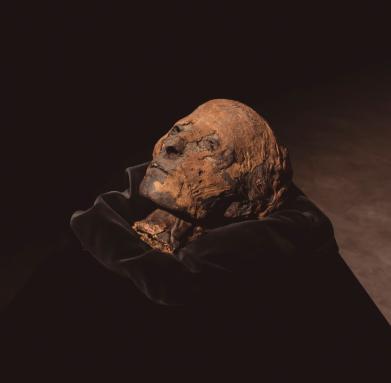

A Mummy’s Head from Imperial Egypt, One of The Main Showpieces at FERIARTE 2019
Nefer was embalmed over 3000 years ago and is perfectly preserved.
FERIARTE will be displaying a piece of great historical value that will be the main attraction at this year’s Fair: a female head of an Egyptian mummy from the 18th Dynasty (1550 to 1295 BCE) considered the period of maximum splendour of the civilisation of the Pharaohs, and a time of major territorial expansion. This was the beginning of Egypt’s Empire or New Kingdom, a historical period in which women had a prominent role, as evidenced by the reigns of Hatshepsut and Nefertiti.
The mummy’s head will be on display on the stand of Ifergan, a gallery in Malaga specialising in archaeology that is showing for the first time this year at FERIARTE. The piece was acquired at auction in New York after a tough bidding session and is perfectly preserved. Its price is approximately €550,000, and around the face there are still preserved pieces of the linen bandages with which it was mummified, as well as all the surfaces of the skin, eyelids, teeth, the blond hair and the most important thing: it still has the cervical vertebra which proves that it was separated from the body with the utmost care. Although Nefer’s true identity is unknown, it is believed that she was probably a noblewoman who died young.
The story of this piece dates back to the late 19th century when Danish doctor Christian Fenger worked in Alexandria and Cairo curing children’s eye infections. After contracting a lung disease due to the African tropical climate, he decided to move to the United States. When he was leaving, an Egyptian officer gave him two mummies in gratitude for his services. However, for logistical reasons when the time came to make the journey, the doctor only took the heads with him. When Fenger died, the heads were inherited by his son Frederich and, later, by his grandson Christian, who decided to sell them.
After acquiring this piece, its current owner, the collector Vicente Jiménez Ifergan, travelled to Luxor (Egypt) to meet experts and scholars of the Book of the Dead, and to undergo a ritual of protection, respect and conciliation, for protection against the mummy’s curse, a mysterious myth that has surrounded the Egyptian funerary world since Howard Carter discovered the tomb of Tutankhamun in 1922.
FERIARTE is celebrating its 43rd edition this year and there will be other archaeological objects on display that are sure to attract the attention of visitors and collectors interested in ancient civilisations. Among others, there will be a white marble bust of the Roman Emperor Antoninus Pius from the 2nd century C.E. (Ifergan), a torso of the hero Diomedes from the 1st century C.E. (J. Bagot Archaeology), a sculpture of a goddess wearing a peplos over a chiton from the 2nd century C.E. (Jesús Vico) and “Representation of Prince with Orb,” a Roman sculpture in white marble from the 2nd century C.E. (F. Cervera Archaeology Gallery).
Organised by IFEMA, the Art and Antiques Fair will be held from 16th to 24th November in Hall 4 of IFEMA from 11:30 to 20:30.




